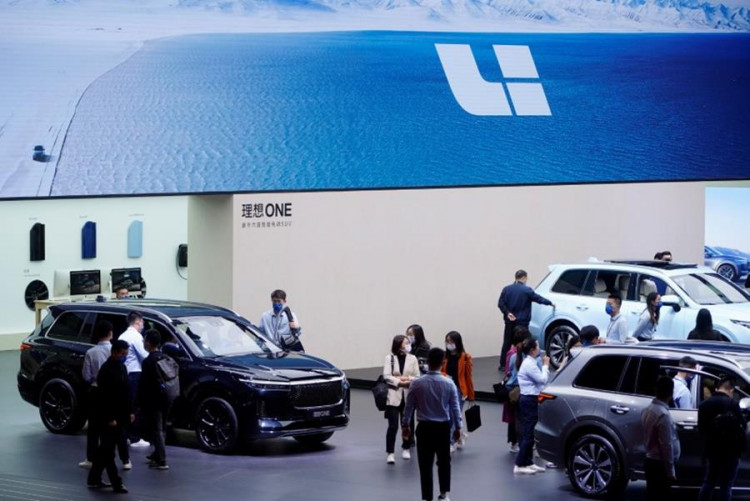The more accomplished one is, the keener they are to share their achievements.
As the forerunner of the emerging domestic automakers, Li Auto disclosed its second-quarter results on August 8th.
Li Auto reported quarterly revenues of ¥286.5 billion, a year-over-year increase of 228.1% and a sequential increase of 52.5%. The net profit stood at ¥23.1 billion, marking positive figures for three consecutive quarters, up from a loss of ¥6.18 billion the same period last year. The automotive gross margin returned to over 20%, hitting 21%, with a sequential rise of 1.2 percentage points. Operational cash flow reached ¥111.1 billion, a year-over-year surge of 8.8 times. Once competing closely with the likes of Weilai, Li Auto has now taken the lead in both sales and profitability.
Despite the price war initiated by Tesla in the electric vehicle market, Li Auto, favored by the market for its product differentiation and extended-range technology, resisted the pressure to cut prices.
In Q2, Li Auto set new records in revenue, profit, and sales. Throughout the first half of the year, Li Auto saw a sharp increase in sales volume and a consistent rise in net profit.
Clearly, amidst the fierce competition in this year's electric vehicle market, Li Auto has distinguished itself.
1. High Sales Volume: A Sign of Current Success and Future Potential
In the first half of this year, among domestic electric vehicle companies that maintained monthly sales over 10,000 units and sustained high growth, BYD and Li Auto stand out.
Monthly sales, which began at 15,000 units in January, rose to 34,000 by July. Notably, during Q2, Li Auto sold a total of 86,500 cars, significantly exceeding the 76,000-81,000 units forecasted.
Li Xiang mentioned on Weibo that production bottlenecks, an issue they couldn't solve this quarter, imply there's still room for sales growth. According to Li Auto's Q3 sales guidance, the company expects deliveries between 100,000 to 103,000 units, representing a year-over-year growth of 277% to 288.3%. Considering that July sales already hit 34,000 units, it suggests that average monthly sales for August and September should remain above 30,000 units.
With its high sales figures, Li Auto not only gains confidence but also paves the way for future growth. The extended-range models L7, L8, and L9 have laid a solid foundation for Li Auto, demonstrating a quick transition from model launches to sales growth.
Yet, Li Auto's product range isn't just limited to extended-range vehicles. After establishing a solid base, Li Auto ventured into pure electric vehicles, further enriching its product lineup. The company has introduced an 800V supercharging solution for electric vehicles, paving the way for future models.
In Q4, Li Auto plans to launch its first 5C pure electric flagship vehicle, the Li Auto MEGA, expanding its offerings and opening up a new growth curve.
2. Li Auto's Era of Profitability
In Q4 2020, Li Auto first reported a positive net profit of ¥1.08 billion. The consistent breaking of the 30,000 monthly sales barrier this year provides a solid foundation for its sustained profitability.
Following a net profit of ¥2.65 billion in the last quarter of the previous year, Li Auto's profit level has maintained rapid growth. The recent Q2 net profit reached ¥23.1 billion, a stark contrast from the ¥6.18 billion loss in the same period last year. Directly correlating with sales, the profit per vehicle rose from ¥5,700 last Q4 to ¥17,700 in Q1 this year, and ¥26,700 in Q2.
Despite Tesla's price war in China's EV market, Li Auto's gross margin dipped for just one quarter, returning to 21% in Q2, with a sequential growth of 1.2 percentage points.
Moreover, Li Auto's cash flow has continued to see high growth this year. In Q2, its operational cash flow reached ¥111.1 billion, an 8.8 times year-over-year growth and a 42.8% sequential growth.
3. Rising Expenses But Not a Major Concern
Previously, with just the Li Auto ONE model, the company's overall R&D expenses were relatively low compared to other emerging automakers.
However, with the launch of new extended-range models, the move into pure electric vehicle development, advanced driving systems, and supercharging solutions, R&D expenses have grown significantly.
In Q2, R&D expenses reached ¥24.3 billion, a year-over-year increase of 58.4% and a sequential growth of 31%. These expenses align with future product plans and current sales figures. As Li Auto still focuses on the domestic market, there's a considerable increase in sales and administrative costs to expand product reach in more cities, enhance sales networks, and elevate brand visibility.
By the end of the second quarter, Li Auto's sales, general, and administrative expenses reached 23.1 billion yuan, marking a year-over-year increase of 74.3% and a quarter-over-quarter rise of 40.4%. The effectiveness of these expenditures is evident. As of the end of July this year, Li Auto boasts 337 retail centers across the country, a surge of 36 from the first quarter, covering 128 cities - up by two cities from the previous quarter. Additionally, there are 323 authorized service and bodywork centers, spanning 222 cities.
Without a doubt, Li Auto has delivered impressive results to the market. As one of the pioneer companies in the new automotive force to become profitable, they have set a standard for other businesses.
However, another challenge for Li Auto might just be on the horizon.
The question remains: Can Li Auto, armed with the popularity and reputation accrued from their range-extended vehicles, continue to maintain their advantage in the pure electric vehicle market? The market eagerly anticipates the answer, especially with the upcoming release of Li Auto's pure electric MEGA brand in the fourth quarter.






